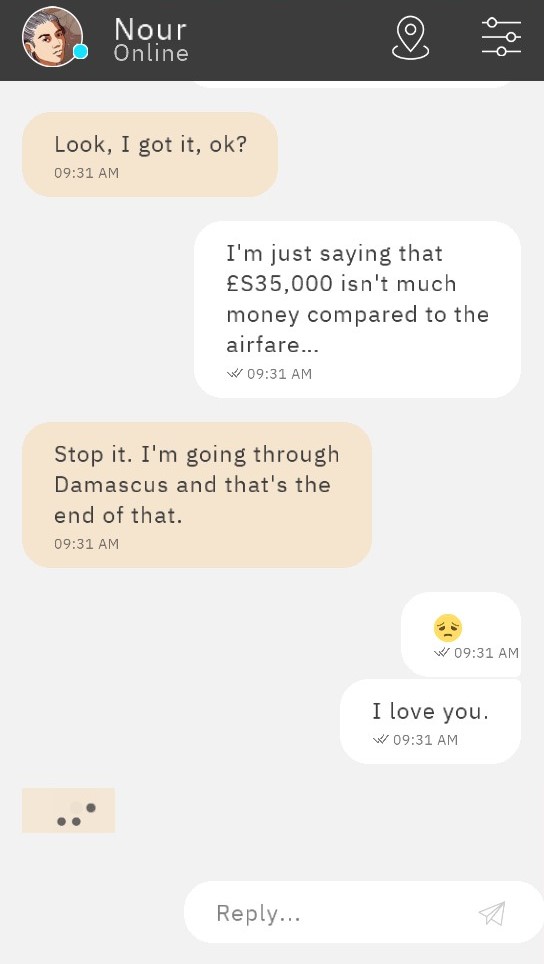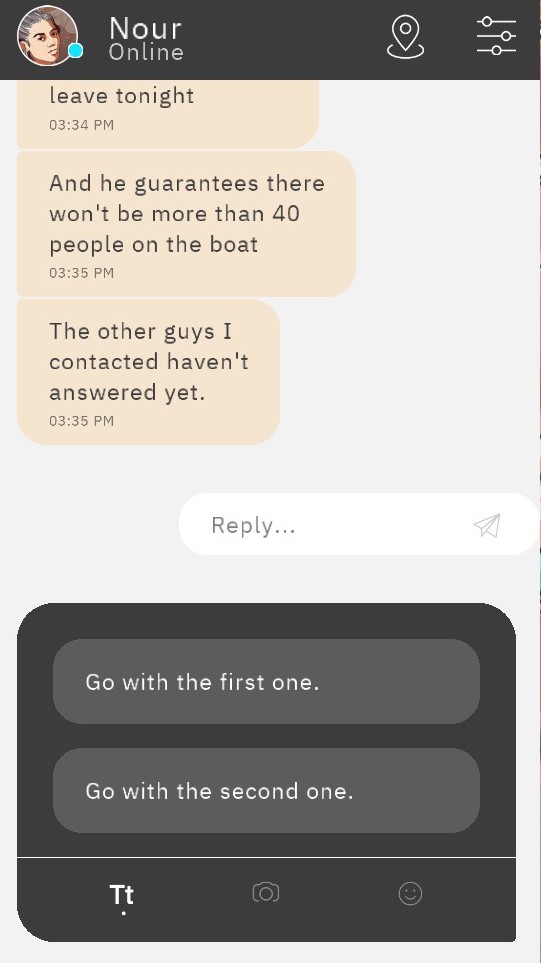About the game
A tale about love, hope and exile, inspired by a true story.
“Bury me, my Love” is a video game that deals with migration, the search for refuge, war, and fate. Unlike other visual narratives, “Bury me, my Love” requires the reader to actively engage in the game and to make difficult decisions. The story will change its course depending on which decisions the player has taken.
The tale begins in Syria on March 4th 2015. Nour and her husband, Majd want to leave war-ridden Syria. Nour, a medical professional, manages to get a visa for Turkey and starts her journey to Europe. Majd is a teacher and has to stay back. The player can influence Nour’s movement via text chat; however, Nour also has a mind of her own, which means that she may not do what the player/Majd asks her to do. On her journey, Nour meets with scammers, racists and more, but she also encounters one or two friendly faces. The player can often choose between sending Nour a text message, an emote or a selfie (of Majd).

An example of Nour’s stubbornness can be found in the beginning. Sadly there is a shooting on her way to the airport. Therefore, Nour decides to go the cheaper route through Damascus, even though the texts that I had chosen and therefore Majd’s answers should have discouraged her.
The decisions that Majd has to make often are hard. After Nour has made it to Izmir because a friend of Majd knows a smuggler there and this friend safely made it to the UK, she contacted the original smuggler and a couple more. Now, the first smuggler is a bit cheaper (900€), but he will only leave the next day and there are 50 people on a 9-meter boat, which is quite a lot. The other smuggler that Nour has found on Facebook will leave tonight, takes 1100€ but guarantees that no more than 40 people will be on board. Now, the following screenshot shows the decision the player has to make after receiving that information.
Which decision am I going to make? Will I go with the presumably trusted but also more dangerous smuggler? Or the more expensive and possibly safer alternative? One of these decisions could cost Nour her life and that is quite a scary thought. It has to be taken into consideration that Nour only got 2,500€, and her journey won’t be over after taking a boat to Greece.

After three playthroughs it becomes clear how difficult it is to get to a safe place, however, on the third playthrough I finally managed to get Nour into Germany.
Experience and Review
Playing the game was an incredibly frustrating experience. Not only is it so hard to get Nour to a safe place, but you’ll also have to read a lot of their chat while only being able to make very few decisions. One playthrough can take up to four hours, which is quite headache-inducing due to the repetitiveness of the gameplay: Read Nour’s messages, read Majd’s automated messages, choose a response, and read Nour’s messages. This may, however, show how difficult it is to be in Majd’s position, who can only watch his phone and wait for Nour’s messages.
Also, things often didn’t go the intended way and that was annoying as well. If a decision was made, it was impossible to go back and retake it, and if Nour died due to the decisions taken, the game had to be played again – from the beginning. There are also so many decisions that it feels impossible to remember which ones I’ve taken in an earlier playthrough. Hence, it would be nice if it was possible to go back to certain chapters in Nour’s and Majd’s journey and see how other decisions would affect her.
Furthermore, the game evokes a sad atmosphere thanks to the music that is played at certain points in the game. The music has a nostalgic undertone, is sad, and often feels a little dramatic. Sometimes the music also sounds almost hopeful. The music underlines the fact that we’re witnessing a family that is being torn apart. A husband who helplessly has to see his wife leave without him. A journey that is dangerous and may separate them infinitely. You can go here to listen to the soundtrack: https://www.youtube.com/watch?v=THLFaJxo-v8
The experience is intense. And frustrating, annoying, and immersive. Overall, the game does a good job of displaying the refugee experience. If you want to read more about the process of designing the game and the developers’ motivation and journey, go here: https://www.gamedeveloper.com/business/the-emotional-rollercoaster-of-making-a-video-game.


